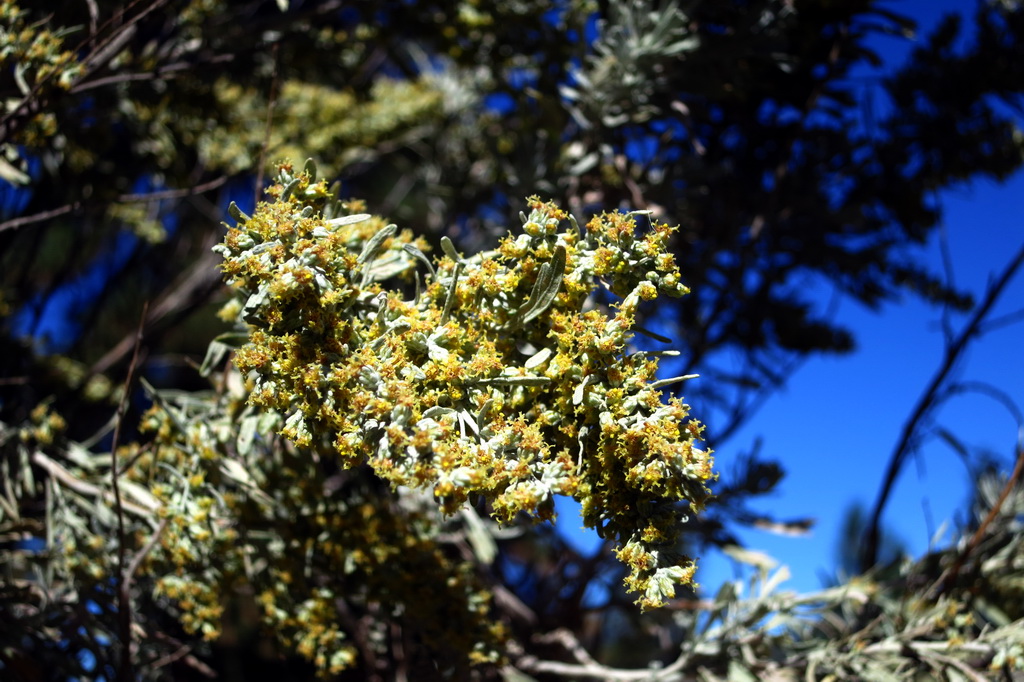 |
| Ponderosa and Lodgepole Pines growing in rocks along the Deschutes River at Lava Lands park. |
We enjoy coming up to the high desert in September or October, after the crowds have thinned out and the weather is cooler. This year our visit coincided with near-perfect sunny dry days and clear, cool nights. It's a great time for hiking and biking, so we did that as much as possible.
From the U.S. Forest Service Lava Lands visitor center, you can see the extent of the cinder cone eruptions. This particular cone erupted about 7,000 years ago, spreading lava over a 25 square mile area. There is an active fire lookout structure and view point at the top of the cone, which you can drive or walk to - we drove!
This late in the season, I did not expect to see many wildflowers, so it was no surprise that my macro lens did not get much use! But the other local natural beauty is hard to resist, with towering Ponderosa pine, Lodgepole pine, Western Juniper, and Manzanita bushes. The reddish volcanic soil color makes a nice contrast to the evergreens, so there is plenty to aim the camera at.
Fortunately, we did spot a few blooms in the high desert area around Bend and Sunriver, where we stayed.
We found these bright pink monkeyflowers growing in the pumice rocks on the way up to the top of Lava Butte. They are either Cusick's Monkeyflower (Mimulus cusickii) or Dwarf Monkeyflower (Mimulus nanus). Both are native and seemed to be growing only on the south side, near the 4,500 foot level.
If you come to this area in late summer or fall, you'll definitely see the native Gray Rabbitbrush (Ericameria nauseosa) blooming throughout the area. It's widespread east of the Cascades and some plants were blooming, while others had gone to seed, showing their prolific reproductive strategy (kind of like rabbits....).
 |
| Rabbitbrush seeds |
On one afternoon, we hiked up Tumalo Mountain (7,775 ft) to get a 360 degree view of the area west of Bend. It's a steep, two mile jaunt through pines and lava rocks, but very popular. Due to "controlled burns" by the Forest Service, the view to the south was a bit hazy, but otherwise expansive. The only flower we spotted on this hike was the Subalpine Lupine (Lupinus arcticus ssp. subalpinus) - and I do mean just one! It was growing in the shade, so it must have been a late bloomer!
Going a few miles east of Bend or Sunriver, the high desert flora changes from pines to junipers and you begin to see miles of sagebrush. Luckily, we did not have to go far to find this sagebrush, as it was planted as part of a natural landscape right in town. It's probably Big Sagebrush (Artemisia tridentata), which is native to eastern Oregon as well as the entire west.
That wraps it up for blooms on this trip. Here's a few more photos of other common high desert flora we saw.
Pondersa pine at left and Whitebark pine at right.
 |
| Greenleaf Manzanita (Arctostaphylos patula). Native. |
With so few blooms to post this time, thought I would throw in these guys to ramp up the cuteness factor! They live a pampered life at the High Desert Museum!
 |
| North American River Otter |
 |
| The pair put on quite a show at mealtime! |
Links:
More of my Central Oregon PhotosHigh Desert Museum
Lava Lands Visitor Center
Sunriver Nature Center
Northwest Conifers Website












No comments:
Post a Comment